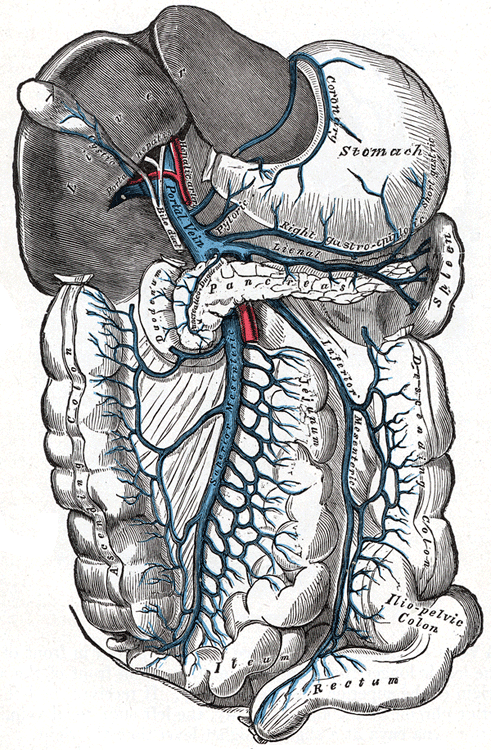Portal hypertension
| Portal hypertension | |
 | |
|---|---|
| The portal vein and its tributaries. | |
| ICD-10 | K76.6 |
| ICD-9 | 572.3 |
| DiseasesDB | 10388 |
| eMedicine | radio/570 med/1889 |
| MeSH | D006975 |
Editor-In-Chief: C. Michael Gibson, M.S., M.D. [1]
Please Take Over This Page and Apply to be Editor-In-Chief for this topic: There can be one or more than one Editor-In-Chief. You may also apply to be an Associate Editor-In-Chief of one of the subtopics below. Please mail us [2] to indicate your interest in serving either as an Editor-In-Chief of the entire topic or as an Associate Editor-In-Chief for a subtopic. Please be sure to attach your CV and or biographical sketch.
Overview
In medicine, portal hypertension is hypertension (high blood pressure) in the portal stem which causes an obstruction in the portal vein and its branches. It is often defined as a portal pressure gradient (the difference in pressure between the portal vein and the hepatic veins) of 12 mm Hg or greater. Many conditions can result in portal hypertension. In North America and Europe, it is usually the result of an intrahepatic block due to cirrhosis of the liver. However, in less industrialized parts of the world, climate permitting, the major cause is schistosomiasis.
Signs and symptoms
Consequences of portal hypertension are caused by blood being forced down alternate channels by the increased resistance to flow through the portal system. They include:
- Ascites (free fluid in the peritoneal cavity)
- Hepatic encephalopathy
- Increased risk of spontaneous bacterial peritonitis
- Increased risk of hepatorenal syndrome
- Splenomegaly (enlargement of the spleen) with consequent sequestration therein of red blood cells, white blood cells, and platelets, together leading to mild pancytopenia
- portacaval anastomoses (Esophageal varices, hemorrhoids, caput medusae), with esophageal varices posing an ongoing risk of life-threatening hemorrhage.[1]
Differential Diagnosis
Prehepatic
- Congenital abnormalities
- Idiopathic tropical splenomegaly
- Portal vein occlusion
- Splenic Vein Thrombosis
- Umbilical sepsis
Intrahepatic
- Alcoholic hepatitis
- Boeck's Diesease
- Chronic hepatitis
- Cirrhosis
- Fatty liver
- Fulminant hepatic failure
- Hodgkin's Lymphoma
- Osteomyelosclerosis
- Partial nodular transformation
- Schistosomiasis
- Wilson's Disease
Posthepatic
- Cardiomyopathy
- Congestive Heart Failure
- Constructive Pericarditis
- Inferior vena cava obstruction
- Tricuspid insufficiency
Treatment
Medical management
Treatment with a non-selective beta blocker is often commenced once portal hypertension has been diagnosed, and almost always if there has already been bleeding from esophageal varices. Typically, this is done with either propranolol or nadolol. The addition of a nitrate, such as isosorbide mononitrate, to the beta blocker is more effective than using beta blockers alone and may be the preferred regimen in those people with portal hypertension who have already experienced variceal bleeding. In acute or severe complications of the hypertension, such as bleeding varices, intravenous octreotide (a somatostatin analogue) or intravenous terlipressin (an antidiuretic hormone analogue) is commenced to decrease the portal pressure.
Percutaneous interventions
Transjugular intrahepatic portosystemic shunting is the creation of a connection between the portal and the venous system. As the pressure over the venous system is lower than over a hypertensive portal system, this would decrease the pressure over the portal system and a decreased risk of complications.
Surgical interventions
The most definitive treatment of portal hypertension is a liver transplant.
References
- ↑ Sailer, Christian, Wasner, Susanne. Differential Diagnosis Pocket. Hermosa Beach, CA: Borm Bruckmeir Publishing LLC, 2002:291
External links
- VIDEO - Portal Hypertension: Shunt Surgery in the Era of Transplant and TIPS, Alysandra Lal, MD, speaks at the University of Wisconsin School of Medicine and Public Health (2007)
Template:SIB Template:Gastroenterology